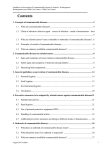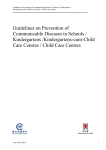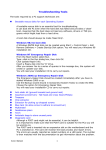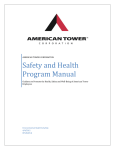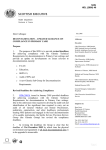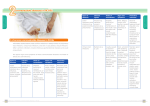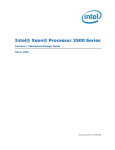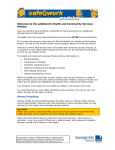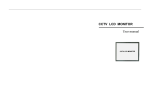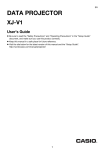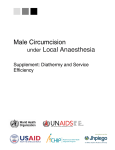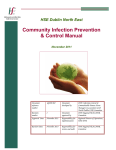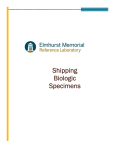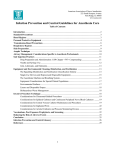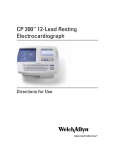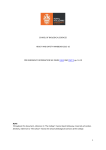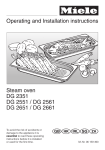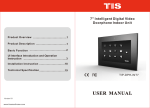Download Guidelines on Prevention of Communicable Diseases in Residential
Transcript
Guidelines on Prevention of Communicable Diseases in Residential Care Homes for Persons with Disabilities Guidelines on Prevention of Communicable Diseases in Residential Care Homes for Persons with Disabilities Centre for Health Protection Department of Health February 2011 Guidelines on Prevention of Communicable Diseases in Residential Care Homes for Persons with Disabilities Introduction ....................................................................................................................................................... 5 1. Concepts on communicable diseases ........................................................................................................ 6 1.1 What are communicable diseases? ......................................................................................................... 6 1.2 Chain of infection: infective agent - source of infection - mode of transmission - host ......................... 6 1.2.1 1.2.2 1.2.3 1.2.4 Infective agent ........................................................................................................................... 6 Source of infection .................................................................................................................... 6 Mode of transmission ................................................................................................................ 6 Host ........................................................................................................................................... 6 1.3 Modes of transmission of communicable diseases and examples .......................................................... 7 1.4 Principles of communicable diseases control – Breaking the chain of infection ................................... 8 1.5 Why RCHDs are more vulnerable to outbreaks of communicable diseases? ......................................... 9 1.6 Key points on basic management of communicable diseases in RCHDs ............................................... 9 2. Recognition of infections ........................................................................................................................... 10 2.1 Signs and symptoms of some communicable diseases ........................................................................... 10 2.2 Observation and assessment ................................................................................................................... 10 2.3 Measuring body temperature .................................................................................................................. 10 2.3.1 2.3.2 2.4 Proper use of thermometers .................................................................................................................. 12 2.4.1 2.4.2 2.4.3 2.5 3. 3.1 General hygiene advice ...........................................................................................................................15 Personal hygiene .................................................................................................................................. 15 Food handlers .......................................................................................................................... 19 Kitchen .................................................................................................................................... 19 Choice of food ......................................................................................................................... 19 Food preparation ..................................................................................................................... 19 Food storage ............................................................................................................................ 20 Environmental hygiene ........................................................................................................................ 20 3.3.1 3.3.2 3.3.3 3.3.4 3.3.5 3.4 Hand hygiene .......................................................................................................................... 15 Handwashing ........................................................................................................................... 15 Alcohol-based handrub ........................................................................................................... 16 Hand hygiene technique .......................................................................................................... 16 When to perform hand hygiene ............................................................................................... 17 Respiratory hygiene and cough manners ................................................................................. 18 Skin care.................................................................................................................................. 18 Food hygiene ........................................................................................................................................ 19 3.2.1 3.2.2 3.2.3 3.2.4 3.2.5 3.3 Choice of thermometers .......................................................................................................... 12 Methods of taking body temperature....................................................................................... 13 Cleaning and disinfection of thermometers after use .............................................................. 14 What should be done when a resident develops fever? ........................................................................ 14 3.1.1 3.1.2 3.1.3 3.1.4 3.1.5 3.1.6 3.1.7 3.2 The importance of taking body temperature ............................................................................. 10 Core and surface temperature .................................................................................................. 11 Choice of disinfectants ............................................................................................................ 21 General cleansing .................................................................................................................... 21 Cleansing and disinfection measures for toilets and bathrooms .............................................. 21 Domestic waste disposal ......................................................................................................... 22 Disinfection of cleansing tools ................................................................................................ 22 Vaccination .......................................................................................................................................... 22 Page 3 4. 4.1 Infection control measures ......................................................................................................................23 Standard precautions ............................................................................................................................ 23 4.1.1 4.1.2 4.1.3 4.1.4 4.1.5 4.1.6 4.2 Hand hygiene .......................................................................................................................... 23 Respiratory hygiene and cough manners .................................................................................23 Use of personal protective equipment (PPE)........................................................................... 23 Cleansing and disinfection of used or exposed articles ........................................................... 26 Sharps disposal and prevention of sharps injury ..................................................................... 26 Clinical waste disposal ............................................................................................................ 26 Transmission-based precautions ........................................................................................................... 27 4.2.1 4.2.2 4.2.3 Contact precautions ................................................................................................................. 27 Droplet precautions ................................................................................................................. 27 Airborne precautions ............................................................................................................... 28 4.3 Visitors ................................................................................................................................................. 28 4.4 Isolation measures ................................................................................................................................ 29 4.5 Prevention of healthcare-associated infections..................................................................................... 29 4.5.1 4.5.2 Prevention of urinary catheter-associated infections ............................................................... 29 Prevention of aspiration pneumonia associated with nasogastric tube feeding ....................... 30 4.6 Prevention of infection for persons with cognitive impairment ........................................................... 30 4.7 Care of residents recently discharged from hospitals ........................................................................... 30 5. Outbreak of communicable disease .......................................................................................................31 5.1 What does outbreak of communicable disease mean? ......................................................................... 31 5.2 What should be done if outbreak is suspected? .................................................................................... 31 5.3 Is notification only applicable to confirmed cases of statutory notifiable communicable diseases? .... 32 5.4 General guidelines on management of suspected outbreak of communicable disease ......................... 33 5.5 Disinfection and cleansing during an outbreak of communicable disease ........................................... 33 5.5.1 5.5.2 5.6 Specific recommendations on management of selected communicable diseases ................................. 34 5.6.1 5.6.2 5.6.3 5.6.4 6. Decontamination of the environment ...................................................................................... 33 Handling of linen .................................................................................................................... 33 Outbreak of respiratory tract infection .................................................................................... 34 Outbreak of acute gastroenteritis (AGE) ................................................................................. 34 Outbreak of scabies ................................................................................................................. 35 Food poisoning ........................................................................................................................ 35 Roles of RCHD staff ................................................................................................................................36 6.1 Responsibilities of operators or home managers of RCHDs ................................................................ 36 6.2 Roles of ICO ........................................................................................................................................ 37 6.3 Useful telephone numbers .................................................................................................................... 38 6.4 Useful websites .................................................................................................................................... 38 Appendix A: List of signs and symptoms of some communicable diseases ......................................... 39 Appendix B: Checklist on signs and symptoms of infections ...............................................................40 Appendix C: Residents fever record ..................................................................................................... 41 Appendix D: Five keys to food safety ................................................................................................... 42 Appendix E: Disinfectants .................................................................................................................... 43 Appendix F: Preparation and use of bleach .......................................................................................... 44 Appendix G: Cleansing and disinfecting commonly used medical items and articles in RCHDs ........ 45 Appendix H: Notification mechanism for communicable diseases in RCHDs ..................................... 47 Appendix I: Statutory notifiable communicable diseases (as at 08/10/2010) ....................................... 48 Appendix J: Notification form for suspected infectious disease outbreak in RCHD ............................ 49 Appendix K: Required information for outbreak investigation ............................................................ 50 Members of Editorial Board.................................................................................................................. 51 Page 4 Introduction Effective prevention of communicable diseases is vital in every residential care home for persons with disabilities (RCHD)1 and it is incumbent on every staff member and carer2 to maintain vigilance. This not only safeguards the health of the residents 3 and the staff by minimising the harm caused by the diseases, but also reduces the chance of hospitalisation of the residents and thus helps to save community resources. We intend to provide practical information on prevention of communicable diseases for those working in institutions for persons with disabilities (PWDs). Every staff member should understand these guidelines and undertake preventive measures accordingly. These guidelines comprise six sections. While individual staff member may refer to the relevant sections as necessary, the infection control officers (ICOs) should familiarise with the content to coordinate the infection control issues and prevent the spread of communicable diseases within their institutions. This set of guidelines does not meant to be exhaustive. For the most updated information, please visit the Centre for Health Protection (CHP) website at www.chp.gov.hk. Lastly, we would like to take this opportunity to thank the Hospital Authority and the Social Welfare Department for their generous and valuable advice on the preparation of these guidelines. Editorial Board Centre for Health Protection Department of Health February 2011 RCHDs refer to residential care homes for persons with disabilities (PWDs) in this set of guidelines. The guidelines are intended for RCHDs. Staff of day centres for PWDs can take reference of the relevant part of this set of guidelines. 1 Carers refer to family members, relatives, guardians or guarantors of PWDs who look after PWDs outside the RCHDs in this set of guidelines. 2 3 Residents refer to residents of RCHDs in this set of guidelines. Page 5 1. Concepts on communicable diseases 1.1 What are communicable diseases? Communicable diseases refer to the diseases that can be transmitted and make people ill. They are caused by infective agents (pathogens) that invade human body or release toxins to cause damages to normal body cells and their functions. In severe cases, they may lead to death. 1.2 Chain of infection: infective agent - source of infection - mode of transmission - host There are four crucial factors for the spread of communicable diseases, namely the „infective agent‟, the „source of infection‟, the „mode of transmission‟ and the „host‟ the so-called „chain of infection‟. 1.2.1 Infective agent An infective agent is a micro-organism (e.g. bacteria, viruses, fungi and parasite) that will cause an infection. 1.2.2 Source of infection This refers to any environment, in which infective agents can live, parasitise and breed. It includes infected human (e.g. patients, carriers and people with latent infections), livestock, insects and soil. The source of infection will normally form the basis for the infective agents to infect humans. 1.2.3 Mode of transmission This refers to the method of transfer by which the infective agent moves or is carried from one place to another. Some communicable diseases have more than one mode of transmission, e.g. chickenpox can be transmitted by contact or air-borne transmission. Please refer to the Section 1.3 for more details about the mode of transmission of some common communicable diseases. 1.2.4 Host Hosts refer to the susceptible population. Some people are more prone to infection and become hosts. For instance, young children, elders and patients with chronic diseases are more susceptible to infection because of weakened body immunity. Page 6 1.3 Modes of transmission of communicable diseases and examples Mode of transmission Contact transmission Droplet transmission Air-borne transmission Examples of communicable diseases Process Through direct body contact with the infected person, e.g. playing together with direct skin contact; or through indirect contact with objects soiled by infective agents, e.g. sharing towels, combs and clothes Inhale or contact of droplets expelled from the sick during sneezing, coughing, spitting and speaking, or through subsequent touching of the mouth, nose and eyes with hands soiled with infective agents The infective agents float in the air for some time and enter the body through the respiratory tract Food-borne / water-borne transmission Through ingestion of contaminated food or water, or use of contaminated eating utensils Vector-borne transmission Through vectors, usually insects. The infective agents parasitise and breed in the bodies of the insects Blood / body fluid transmission Through blood transfusion, tattooing, ear piercing or sexual intercourse Congenital infection From the pregnant mother to the foetus Acute conjunctivitis Chickenpox # Hand, foot and mouth disease Head lice Herpes zoster infection Methicillin-resistant Staphylococcus aureus (MRSA) infection Scabies Acute bronchiolitis Pneumonia Seasonal influenza Severe acute respiratory syndrome (SARS) Chickenpox# Measles Pulmonary tuberculosis (Smear positive) Bacillary dysentery Cholera Escherichia coli infection Food poisoning Hepatitis A Hepatitis E Norovirus infection Viral gastroenteritis Mosquito-borne: Dengue fever Japanese encephalitis Malaria Hepatitis B Acquired Immune Deficiency Syndrome (AIDS) Congenital rubella syndrome Congenital syphilis Congenital cytomegalovirus infection # Some communicable diseases have more than one mode of transmission (e.g. chickenpox). Page 7 1.4 Principles of communicable diseases control – Breaking the chain of infection As mentioned in 1.2, „infective agent‟, the „source of infection‟, the „mode of transmission‟ and the „host‟ are crucial factors to the spread of communicable diseases. Hence, to break the „chain of infection‟ - controlling the spread of communicable diseases should focus on controlling these four factors: Factors of transmission Infective agent Control measures Disinfection to kill the infective agents Early detection, isolation and treatment of the sick person Source of infection Removal of breeding sites Mode of transmission Host (susceptible population) Maintenance of good personal, environmental and food hygiene Adoption of infection control measures appropriate to the different modes of transmission Building up personal immunity by immunisation and healthy lifestyle Page 8 1.5 Why RCHDs are more vulnerable to outbreaks of communicable diseases? RCHDs are collective living places where communicable diseases can easily spread through close person-to-person contact. The frailty of persons with disabilities also aids the spread. The source of infection can be staff, carers, visitors or residents (e.g. resident who is newly discharged from the hospital). Person-to-person contact may lead to cross-infection, i.e. transmission of infective agents from one person to another. For example, a staff member who fails to perform hand hygiene between caring of different persons, may spread the infective agents from that person to the next person he/she cares for. 1.6 Key points on basic management of communicable diseases in RCHDs The home managers have the accountability to ensure their infection control practices are up to standard in their institutions. It is recommended that a designated staff should be appointed for overseeing all the infection control issues in an institution and the staff should have undergone infection control training. The following principles in preventing the spread of communicable diseases should be observed: Medical surveillance - Monitor residents and staff condition closely, watch out for any sign and symptom of infection, and maintain residents‟ personal health records properly. Early treatment - Arrange prompt treatment for the infected person to prevent further spread of infection by that person. Spread prevention - Implement appropriate infection control measures according to the mode of transmission of the concerned communicable disease to prevent its spread. For example, wear a mask when having respiratory symptoms; handle and dispose body fluid, secretion and excretion properly; perform proper hand hygiene; enhance environmental cleansing; and notify the Department of Health and other concerned government departments promptly for investigation and appropriate advice. Page 9 2. Recognition of infections 2.1 Signs and symptoms of some communicable diseases The typical signs and symptoms of some communicable diseases are listed in Appendix A for quick reference. The list is not meant to be exhaustive. For more information about different types of communicable diseases, please visit the CHP website: www.chp.gov.hk . Please note that many other diseases may also cause the above signs and symptoms. These complaints should be compared with the past health record of the individual. As fever is a common presenting symptom, residents‟ temperature should be checked regularly and their personal health records should be properly maintained. 2.2 Observation and assessment Infections can be identified by observing and monitoring of certain signs and symptoms. Staff and carers should pay more attention to those with special health conditions or medical devices as these residents are more prone to infections. It is a good practice for the infection control officer (ICO) to conduct a preliminary health assessment for those who were suspected to have infection with the “Checklist on signs and symptoms of infections” (Appendix B) and seek prompt advice from the medical professionals. Arrange the resident for urgent medical consultation once he/she is found to have the following conditions: Disorientation, confusion, restlessness Weaker than usual Lethargy Fall Shortness of breath Increased or irregular heart rate Unexplained changes in behaviour and body functions (e.g. loss of bladder control or faecal incontinence) Person with untreated infection may serve as a reservoir and continue spreading the infective agents to the others. Thus, it is very important to detect infected persons early. 2.3 Measuring body temperature 2.3.1 The importance of taking body temperature Most people develop fever when being infected, but there are exceptions. Some people have lower baseline body temperatures, even their body temperatures have raised during infection, the body temperatures may still be within the reference range. These changes can only be identified when their usual body temperatures are monitored on a regular basis. Therefore, it is a good practice to check and document the body temperature of high risk residents daily. Page 10 Besides, residents with the following conditions should have their body temperature checked more frequently: Being feeble With communication problems Having symptoms of infection Recently discharged from hospital Having been exposed in communicable diseases outbreaks, particularly acute respiratory diseases If the temperature deviates from the resident‟s usual body temperature, he/she may have an underlying infection. 2.3.2 Core and surface temperature Body temperature can be divided into core temperature and surface temperature. Core temperature refers to the temperature of deep tissues and can be taken through the oral cavity, rectum or ears; whereas surface temperature is the temperature of surface skin tissues and can be taken through the forehead or armpits. Comparatively, surface temperature is more easily affected by the surroundings. To avoid inaccurate measurement, staff should: Be familiar with the correct use of thermometers. Use the same temperature taking method for each resident. Take temperature from the same body part around the same time every day to avoid deviations caused by changes in the surroundings. Defer temperature-taking when residents having exercise, after bathing or foods and drinks within 30 minutes. Body temperature varies with age, time of the day and level of physical activity. For screening purpose, temperature above the reference reading quoted below will be considered as significant and staff should arrange medical consultation for the resident if fever is suspected. Measuring method Celsius scale (˚C) Fahrenheit scale (˚F) Ear 38.0˚C 100.4˚F Oral 37.5˚C 99.5˚F Armpit 37.3˚C 99.1˚F Rectal 38.0˚C 100.4˚F Page 11 2.4 Proper use of thermometers 2.4.1 Choice of thermometers There are digital, mercury and infrared thermometers in the market for oral, rectal, armpit, ear and forehead temperature measurement. Accuracy, suitability and convenience should all be taken into account in choosing the appropriate thermometer. Before using a specific thermometer, read the instructions carefully for the proper procedures and the reference range of the readings. Infrared forehead thermometers are less accurate in reflecting the true core body temperature, although some institutions are using it for the routine temperature checking, it should not be the only available thermometers in institutions. Whenever in doubt, staff should use another type of thermometer to recheck the body temperature. To reduce the risk of cross-infection, allocate a designated thermometer to each resident, especially those having an infection. Page 12 2.4.2 Methods of taking body temperature Method Ear Steps for measuring (1) (2) (3) (4) (5) (6) (7) Oral (1) (2) (3) (4) (5) (6) Armpit (1) Switch on and check the functions of ear thermometer. Cover the probe tip with a plastic probe cover. Stabilise the position of the person‟s head. Pull the ear backward and upward to straighten the ear canal and gently place the probe deep into the ear canal. Press the SCAN button. Remove the thermometer from the ear when it beeps. Read digital display and record accordingly. Ensure the person is conscious, cooperative and be able to close his or her mouth tight. Cover the thermometer with a plastic shield. Place the oral thermometer under the tongue near the root. Instruct the person to close the mouth tight, and do not speak or bite on the thermometer. Remove the digital thermometer when it beeps and check the reading. For a mercury thermometer, remove the thermometer after 3 minutes and check the reading. Record accordingly. Put the thermometer under the armpit. (2) Place the person„s forearm horizontally on the chest to hold the thermometer in position. (3) Wait for 6 to 8 minutes before checking the reading. (4) Mark the value clearly in record as armpit temperature. Points to note Recommendations The ear temperature is usually 0.5℃ higher than the oral temperature. Direction of the probe tip should be correct; otherwise it will give an inaccurate reading. The ear pressed against the pillow during bed rest has higher temperature, so the other ear should be used for taking temperature. Non-invasive, fast response time and with an easy-to-read display. Not applicable for person with otitis or with obstruction of ear canal caused by ear wax. Avoid cold or hot foods and drinks for at least 30 minutes before taking temperature. Not applicable for persons who are unconscious, confused or who cannot close their mouths tight. If the resident accidentally bites off the mercury thermometer, he/she should be sent to the hospital immediately without delay. Armpit temperature is usually lower than oral temperature. The thermometer should be held tightly under the armpit when taking temperature. Ensure the privacy of the residents and protect them from catching cold when taking temperature. Unless for the very thin person with a socket-like hollow armpit, armpit measurement is suitable for conditions when all of the above temperature measurement methods are not applicable. Page 13 2.4.3 Cleaning and disinfection of thermometers after use Thermometers cannot be disinfected by heating methods as heat can affect their functions and cause damage. Electronic thermometers There are various types of electronic thermometers in the market. Some can be immersed in disinfectant while some cannot. To ensure proper maintenance of the thermometers, read and follow the user manual for the recommended cleansing and disinfection method. Mercury thermometers Handle oral and rectal thermometers separately. Wash thermometers with cold water and detergent until clean. Immerse in 70% alcohol for at least 10 minutes. Air dry and then store in a clean container with a cover. 2.5 What should be done when a resident develops fever? If a resident has a temperature higher than the reference value (for details, please refer to Section 2.3.2 ) or 1˚C of his/her baseline, separate him/her from the others and arrange him/her to seek medical advice promptly. Staff should record the body temperature in the resident‟s personal health record as well as mark his/her name or bed number in the “Residents fever record” (Appendix C). To enhance early detection of outbreak situation, the Infection Control Officer (ICO) is responsible to monitor residents‟ fever record for any unusual pattern. Page 14 3. General hygiene advice Building up immunity is vital to prevention of communicable diseases. It includes having a well balanced diet, adequate rest and sleep, regular exercise and being a non-smoker. Good personal, food and environmental hygiene should be observed. Since many germs are transmitted through contact or droplet, performing hand hygiene properly and maintaining respiratory hygiene are two prerequisites for the prevention of infections. Besides observing their own personal hygiene practices, staff should also supervise and provide support to residents and visitors to enhance their good personal hygiene practices. 3.1 Personal hygiene 3.1.1 Hand hygiene Hand hygiene is a prerequisite for the prevention of many infections. Two hand hygiene practices are recommended: hand washing with liquid soap and using alcohol-based handrub. Home managers of institutions should provide adequate facilities and put alcohol-based handrub at convenient locations to facilitate staff and residents to perform hand hygiene practices. They should also remind residents and staff of the following: Remove artificial nails, rings, watches and bracelets as they may harbour infectious organisms. Perform hand hygiene after taking off gloves. Even though gloves are worn, hand hygiene can never be substituted. Observe proper hand hygiene techniques irrespective of whether hand washing with liquid soap or alcohol-based handrub is used. Staff should perform and assist residents to perform hand hygiene when necessary, e.g. before each meal (for details, please refer to Section 3.1.5 ). 3.1.2 Hand washing Wash hands with liquid soap and water when hands are visibly soiled or likely contaminated with body fluid. Rub all parts of the hands including the wrists with proper hand hygiene technique for at least 20 seconds (for details, please refer to Section 3.1.4 ). Do not re-contaminate washed hands by touching the faucet directly or sharing towel with others. Use disposable paper towel or hand dryer to dry hands. Page 15 3.1.3 3.1.4 Alcohol-based handrub Using 70-80% alcohol-based handrub to rub hands is effective to prevent contracting and spreading communicable diseases via hands when hands are not visibly soiled. Same as hand washing, rub all parts of the hands including the wrists with proper hand hygiene technique for at least 20 seconds (for details, please refer to Section 3.1.4 ). Allow alcohol to evaporate naturally for maximum effect. No need to use paper towels to dry the hands after applying alcohol handrub. Hand hygiene technique Page 16 3.1.5 When to perform hand hygiene It is impossible to list out all situations when hand hygiene is needed. hand hygiene should be performed: Basically, General: after sneezing or coughing after using toilet before touching the eyes, nose, mouth or mucous membrane before preparing, handling, serving food or eating after touching soiled objects or environments Related to personal care: before and after carrying out nursing procedure involving direct body contact before performing a procedure involving an invasive medical device (e.g. urinary catheter) after contacting blood, body fluid, secretion, excretion, wound or mucous membrane, e.g. changing diaper or cleansing of respiratory secretions after taking off gloves Page 17 3.1.6 Respiratory hygiene and cough manners Everyone should observe respiratory hygiene: No spitting. Cover both the nose and mouth with tissue paper when coughing or sneezing. Wrap up respiratory secretion with tissue paper and discard it into nearby garbage bins with lids or flush them away in the toilet. Perform hand washing with liquid soap and water immediately after contacting respiratory secretion or touching objects soiled with respiratory secretions. Put on a surgical mask while having respiratory symptoms. Home managers of institutions should ensure the availability of materials for residents and staff to adhere to “Cough Manners”: Provide tissue paper and non-touch garbage bin with lid for disposal of used tissue. Provide adequate hand washing items (i.e. liquid soap, paper towels) near sinks, and alcohol-based handrubs at convenient places for use. Put up signage and remind people not to spit. 3.1.7 Skin care Staff should pay attention to the following points for residents‟ skin care: Help residents to check their skin condition and pay particular attention to skin fold under the armpit, around the neck and groin area. Assist dependent residents to dry the skin fold between the toes properly and do not use talcum powder as it forms crusts and causes skin irritation. Cleanse and cover abrasion, if present, with dressing to prevent wound infection. Advise ambulant residents to put on socks or shoes to prevent abrasion around the soles or toes. Page 18 3.2 Food hygiene 3.2.1 Food handlers Staff having fever, diarrhoea or vomiting should inform their employers, seek medical advice and be refrained from handling food. If there is wound on hands, cover it with waterproof dressing to prevent passing infective agents from the wounds to food. 3.2.2 Kitchen Keep kitchen clean and tidy. Clean exhaust fan and range hood regularly. Keep worktops and floor in kitchen clean and dry. Do not store personal items in kitchen, such as clothes and shoes. Store utensils in a clean cupboard. Always cover garbage bins to avoid breeding of cockroaches, flies and rodents. 3.2.3 Choice of food Buy fresh meat and vegetables. Do not patronise illegal food hawkers. Do not buy packaged food without proper labelling, beyond its expiry date or with damaged packages. Do not buy ready-to-eat food and drinks that are displayed together with raw products. Do not buy foods which look, smell or taste abnormal. Avoid unpasteurised dairy products like raw milk. Do not buy excessive food to avoid prolonged storage. 3.2.4 Food preparation Wash hands properly before preparing food. Wear mask, cap and apron (washable or disposable) during food preparation. Wash food thoroughly or scrub them with a brush when appropriate. Handle and store raw food and cooked food separately. Use separate knives and chopping boards for raw and cooked food to avoid cross-contamination. Thaw frozen food completely before cooking. The recommended thawing method are: thawing in refrigerator thawing under cold running water thawing by a microwave oven Cook or reheat foods thoroughly before consumption. Do not touch cooked food with bare hands. Page 19 3.2.5 Food storage Keep the storage place clean to avoid pest infestation. Store food in well-covered containers. Label the expiry date of food which has been prepared and stored for serving later. Never leave perishable food in room temperature. Store perishable food in the refrigerator immediately after purchasing. Before refrigeration, pack the food into smaller portions if it is not intended for use in one go. Dispose of surplus food. If surplus food needs to be retained, store it in a refrigerator. Keep the temperature inside refrigerator at or below 4˚C and freezer at or below -18˚C. Regularly monitor temperatures of refrigerator and freezer to ensure they are functioning properly. Each refrigerator should have a temperature log book. Cleanse freezer or refrigerator at regular intervals. Avoid over-packing to allow adequate ventilation inside the refrigerator. Do not wrap food directly with newspaper, unclean paper or coloured plastic bags. Do not prepare too much food at one time to avoid wastage or over-stocking. Follow “Five Keys to Food Safety” (Appendix D) for safe food preparation. 3.3 Environmental hygiene Since infective agents can survive in the environment for a period of time, it is essential to observe environmental hygiene. Maintain good indoor ventilation; open windows wide or turn on exhaust fans. Keep appropriate distance between beds (not less than 1 metre) for persons with infectious diseases which are transmitted via droplets to reduce the chance of transmission. Empty water in the saucers underneath flower pots and change water in vases at least once a week. Top up all defective ground surfaces to prevent accumulation of stagnant water and breeding of mosquitoes. Avoid stacking of unnecessary articles to prevent rodent infestation. Commence clean-up actions immediately if there are any signs of pest or rodent infestation such as cockroaches, mosquitoes, flies, rats and their excreta. Do not keep pets like dogs, cats, poultry or birds in RCHDs. Page 20 3.3.1 Choice of disinfectants Household bleach generally contains 5.25% sodium hypochlorite solution. It is an effective disinfectant when it is diluted appropriately (Appendix E). Care should be taken to avoid its use in metal surfaces since chlorine is corrosive to metal. Please refer to Appendix F for procedures of preparing diluted bleach. 1 in 99 diluted household bleach is adequate for usual situation. Use 1 in 49 diluted household bleach for surfaces or articles soiled with respiratory secretions, vomitus or excreta and in outbreak situation. Use 70% alcohol to disinfect metal surfaces. Apart from bleach, there are many environmental disinfectants in the market. Purchasers should check the content and note the directions for use because different disinfectant is designed for different targeted agents. 3.3.2 General cleansing Make sure the air-conditioning systems are well-maintained and the air-filters are cleansed regularly. Examine and cleanse residents‟ lockers regularly to avoid food remnants. Cleanse and disinfect frequently touched surfaces and commonly shared items at least daily, e.g. handrails, furniture, computer keyboards. Use 1 in 99 diluted household bleach for non-metallic surfaces and 70% alcohol for metallic surfaces. When there are obvious contaminants such as respiratory secretions, vomitus or excreta, wipe the contaminants away with disposable towels first, then disinfect the surface and its neighbouring areas with appropriate disinfectant. Use 1 in 49 diluted household bleach for non-metallic surfaces and 70% alcohol for metallic surfaces. Allow bleach to leave on the surface for 15-30 minutes before rinsing with water. 3.3.3 Cleansing and disinfection measures for toilets and bathrooms Keep toilets and bathrooms clean and hygienic. Provide liquid soap and disposable paper towels or hand dryers for hand washing. Ensure the flushing system of the toilet is functioning properly all the times. Make sure that the drain pipes are built with U-shaped water traps. Do not alter the pipelines without authorisation. Pour about half a litre of water into each drain outlet regularly (about once a week) so as to maintain the water column in the pipe as water lock to prevent the spread of micro-organisms. Ensure the soil pipes and sewage drains are functioning properly without leakage so as to avoid breeding of infective agents. Page 21 3.3.4 Domestic waste disposal Discard rubbish into a garbage bin with lid. Keep the garbage bins always covered. Empty garbage bins at least once a day, even it is not full. Wash hands thoroughly after handling garbage. 3.3.5 Disinfection of cleansing tools Rinse floor mop, wipers or other cleansing tools with water to remove solid or bulky waste. Immerse them into 1 in 49 diluted household bleach for 30 minutes for decontamination. Then wash with clean water. Re-use after they are thoroughly dried. 3.4 Vaccination Residents of RCHDs may develop severe or even fatal complications when they suffer from influenza. The Department of Health offers free influenza vaccination to residents and staff of RCHDs annually through the Residential Care Home Vaccination Programme. They are encouraged to receive influenza vaccination unless they have contraindications. Free pneumococcal vaccinations are also provided for those residents who are aged 65 or above and have never received the vaccination before. The Department of Health or private doctors may also provide other vaccines to individuals or target groups for protection against certain infectious diseases. Staff or residents who want to get vaccinated for their personal protection can seek advice from doctors and consider the service fee. Page 22 4. Infection control measures Apart from general hygienic practices and vaccination, staff of institutions should also adopt specific infection control measures against communicable diseases. The measures fall under two main categories: Standard precautions Transmission-based precautions In addition, isolating people with specific communicable diseases, urging visitors to observe infection control rules and nursing high-risk person with greater caution, can minimise the risk of communicable disease outbreak in an institution. 4.1 Standard precautions Standard precautions are based on the concepts that all blood, urine, faeces, excreta, saliva, sputum, vomitus, secretions from non-intact skin, wounds and mucous membrane should be treated as potentially infectious. Everyone should take appropriate protective measures when coming into contact with them. These include: Hand hygiene Respiratory hygiene and cough manners Use of personal protective equipment Proper cleansing and disinfection of used or exposed articles Prevention of sharps injury Waste management 4.1.1 Hand hygiene Please refer to section 3.1.1 Hand hygiene 4.1.2 Respiratory hygiene and cough manners Please refer to section 3.1.6 4.1.3 Respiratory hygiene and cough manners Use of personal protective equipment (PPE) Personal protective equipment is the barrier that aims at protecting skin and mucous membranes from exposure to potentially infectious materials thus minimise the risk of being infected. They include gloves, surgical mask (also called facemask), protective gown, goggles, face shield and cap. According to the occupational safety requirement, managements are responsible for ensuring appropriate PPE are provided to staff. Staff should learn how to select and use appropriate PPE according to the risk assessment of nursing procedures and the infectious diseases situations. Page 23 Page 24 A. Gloves Wear gloves when handling blood, body tissues, excreta, body fluid, secretion or contaminated waste. Wear gloves when touching mucosa or wounds. Remove gloves and perform hand hygiene immediately after each task or procedure to prevent cross-contamination between different body sites and transmission of infective agents to other person or environment. Discard used surgical or examination gloves. Do not wash or disinfect them for reuse. Do not double-gloving. B. Surgical mask (also called facemask) Select three-layer designed surgical masks (facemask) for infection control purpose. Encourage person with respiratory symptoms to wear surgical mask to reduce spread of droplets to surrounding area. Wear mask when taking care of residents with respiratory symptoms. Wear mask properly to ensure optimal protection. C. Protective gown Put on long-sleeved protective gown to protect skin, personal clothing or uniforms from soiling with respiratory droplets, blood, body fluid, secretion, urine, faeces or infectious material during the process of care. Remove protective gown after caring of residents or when it is soiled by blood or other potentially infectious fluid. Take off soiled protective gown carefully and perform hand hygiene immediately. D. Goggles and face shield Put on goggles, face shield, mask and water-repellent gown to enhance protection during anticipated splashing situations. E. Cap Wear cap to hold all hair inside to enhance protection during anticipated splashing situations. Page 25 4.1.4 Cleansing and disinfection of used or exposed articles Handle used or exposed instruments and articles carefully as they may become soiled by infective agents. Ensure used or exposed instruments and articles are cleansed thoroughly before storage or subsequent use. Cleanse all visible soils before disinfection. Wipe items such as electrical and electronic equipment with alcohol since they will be damaged by soaking in aqueous solution. Ensure the disinfectant reaches all surfaces, including internal surfaces of lumens. Replace articles with disposable items when they cannot be cleansed or disinfected properly. Please refer to Appendix G for the details on cleansing and disinfection of commonly used medical items and articles in RCHDs. 4.1.5 Sharps disposal and prevention of sharps injury Always take precautions to prevent sharps injury. Use recapping devices when needed. Dispose sharps directly into a puncture-proof and spill-proof container which is labelled with “Sharps Box” and “Biohazard”. Seal sharps box when it is 3/4 full. Pack the sharps box in a well-fastened clinical waste bag by using „swan-neck” sealing method with a warning sign of “Beware of Sharps” for disposal. 4.1.6 Clinical waste disposal Separate clinical waste (e.g. used needles and gauze soaked with blood) from domestic waste. Pack and label clinical waste properly in colour-coded bags with biohazard signs. Wash hands thoroughly after handling clinical waste. Store clinical waste securely before collected by licensed clinical waste collector. Contact the clinical waste collector when there is substantial amount of clinical waste. Keep disposal record of clinical waste properly. Enquiry the Environmental Protection Department (EPD) at hotline 2838 3111 or visit the website of EPD for more information <www.epd.gov.hk/epd/clinicalwaste/nonflash/eindex.html>. Page 26 4.2 Transmission-based precautions Apart from standard precautions, when the infectious agent and its modes of transmission are known, specific preventive measures should be adopted. Some diseases can be transmitted by more than one mode. To prevent the spread of such diseases, combined preventive measures should be considered. 4.2.1 Contact precautions Contact precautions 4.2.2 MRSA infection, Acinetobacter infection, Acute conjunctivitis, Head lice, Scabies, Gastroenteritis Practise hand hygiene stringently Wear PPE depend on the nature of contact, e.g.: Gloves, apron or gown for lifting Mask, gloves and apron for bed-making Cleanse or disinfect used items before subsequent use. Increase the frequency of environmental cleansing and disinfect all frequently-touched surfaces with 1 in 49 diluted household bleach, leave for 15-30 minutes before rinsing with water and wiping dry. Keep infected residents in a partition or a room as advised by doctors. Droplet precautions Droplet Precautions Influenza, SARS, Avian influenza, Let more fresh air in, e.g. open more windows or switch on exhaust fans. Practise hand hygiene stringently. Keep social distance, at least one metre between residents. Advise person with respiratory symptoms to wear mask to reduce spread of droplets to surrounding area. Educate and assist residents to maintain cough manners. Advise carers to wear masks when they are working within 2 metres of the infected; or to wear masks, face shields and put on gowns for certain coughing- or vomiting-induced procedures. Increase the frequency of environmental cleansing and disinfect all frequently-touched surfaces with 1 in 49 diluted household bleach, leave for 15-30 minutes before rinsing and wiping dry. Arrange a separate room for infected residents. Page 27 4.2.3 Airborne precautions Airborne precautions Pulmonary tuberculosis (TB) (smear positive), Chickenpox, Measles Get vaccinated for vaccine-preventable diseases like measles. Identify person with airborne infection and arrange prompt medical consultation. Separate the infected resident from others before transfer. Room isolation is required. When entering the room, non-immunised staff and carers may wear N95 masks or respirators for their own protection. Advise the infected to maintain cough manners and wear mask unless contraindicated. Practise stringent hand hygiene. 4.3 Visitors Advise visitors to comply with infection control measures, including: Perform hand hygiene before and after visits. Maintain cough manners. Beware of their own health conditions. Avoid visiting RCHDs if recently exposed to infectious disease or having any sign or symptom of infectious diseases, e.g. fever Wear surgical masks when having respiratory symptoms. Write down their contact information in the visiting record as requested by the institution or the Department of Health. Follow instructions, e.g. wearing appropriate PPE. Inform visitors when the institution is having an outbreak and they should refrain from visiting as advised by the Department of Health. They may contact the residents by other means such as by telephone. Page 28 4.4 Isolation measures Whenever a resident is suspected to have a communicable disease, doctor should be consulted early for isolation advice. For some highly contagious diseases, room isolation is strongly recommended. Reserve a designated area or room for the isolation purpose. It should not be used for other purpose. Implement appropriate protective measures, including hand hygiene, wearing mask and the use of appropriate PPE when caring residents in the designated area or room. Attend to the physical and psychological needs of the isolated residents to reduce their sense of loneliness. 4.5 Prevention of healthcare-associated infections In addition to the above preventive measures, proper nursing protocols can further reduce healthcare-associated infections in RCHDs, which include the followings: 4.5.1 Prevention of urinary catheter-associated infections Residents requiring indwelling urinary catheter are exposed to a higher risk of urinary tract infections. Risk-reducing methods include: Insert or change urinary catheter by a qualified nurse. Perform hand hygiene thoroughly before and after handling urinary catheter. Encourage residents to drink plenty of water to dilute urine and to optimise urine flow when there is no medical contraindication. Check regularly if residents have malaise, fever, cloudy and smelly urine. If so, seek medical consultation promptly. Always place urine bag below the bladder level to avoid back flow of urine which may lead to urinary tract infection. Clamp drainage tube before raising urinary bag above the bladder level, e.g. change of position. Do not allow the outlet of urine bag touching the floor. Prevent kinking or sagging of urinary catheter to ensure free flow of urine. Do not disconnect urinary bag from the catheter. It should be changed together with a new catheter. If deemed necessary, perform hand hygiene and disinfect the connection part with 70% alcohol swab before and after disconnection. Use liquid soap and water for daily cleansing of urethral opening and removing debris from the surface of urinary catheter during bathing or showering. Page 29 4.5.2 Prevention of aspiration pneumonia associated with nasogastric tube feeding Residents requiring nasogastric tube feeding have higher risk for aspiration pneumonia. Risk-reducing methods include: Change nasogastric tube regularly by a qualified nurse. Observe proper feeding procedures. Prop up the resident in a sitting position of at least 30 degrees. Make sure nasogastric tube is in right position before feed. Ensure each resident has his/her own feeding set. Flush feeding set with water after each feed and air dried before putting it into clean container for the next use. Disinfect reusable feeding bottle daily, e.g. boiling it for 10 minutes after cleansing. Discard disposable feeding tubing daily (Appendix G). Maintain oral and nasal hygiene. Oral cavity should be checked and cleansed at least three times a day. 4.6 Prevention of infection for persons with cognitive impairment Residents with cognitive impairment may develop difficulties in comprehension, expression and self-care. Therefore, they cannot cooperate with staff in performing preventive infection control measures. For residents who retain certain degree of cognition, staff may guide or assist them to adopt good personal hygiene to prevent infection. For residents with serious cognitive impairment, to ensure proper personal and environmental hygiene, staff should pay extra attention and perform cleansing for them. 4.7 Care of residents recently discharged from hospitals Assist the residents to wash their hair, bath and change clothes when they return to RCHD. Monitor their health conditions closely. Measure their body temperature more frequently for the first few days. Advise them to wear surgical masks if they have respiratory symptoms. Advise them to observe personal hygiene. Page 30 5. Outbreak of communicable disease 5.1 What does outbreak of communicable disease mean? From the epidemiological point of view, if people in a RCHD develop similar symptoms one after another and the attack rate is higher than that at usual times, there is an outbreak. A common example is seasonal influenza, outbreaks of which tend to occur more frequently during the influenza peak seasons in January to March and July to August each year. To decide whether there is an outbreak, day-to-day information on cases of communicable diseases in the RCHD has to be monitored. Some examples are cited below for reference. The ICO should closely monitor the situation if: Residents in the same room or on the same floor develop similar symptoms in clusters within a short period of time. Residents and staff concurrently develop similar symptoms in clusters, such as symptoms of influenza (fever, cough and sore throat). This means that cross-infection may have occurred in the RCHD. Two or more people develop similar symptoms after eating common food items. This means that a cluster of food poisoning may have occurred. The infective agent may be bacteria, viruses or toxins contained in the food. A single case of communicable disease may sometimes be treated as an outbreak. For example, a new disease unprecedented in the past or a situation which has major impact on public health like avian influenza in 1997 and SARS in 2003. 5.2 What should be done if outbreak is suspected? Early detection of communicable disease is crucial to the prevention of its spread. Not only the ICOs but all staff members should be responsible for close monitoring of the physical conditions of their residents to ensure early detection of communicable diseases. For any suspected institutional outbreaks of communicable diseases, apart from arranging medical consultation for the sick residents, staff should report the situation to Central Notification Office (CENO) of the Centre for Health Protection (CHP) for investigation. Staff should notify the relevant parties according to Appendix H as soon as possible so that effective control measures can be implemented promptly. Page 31 5.3 Is notification only applicable to confirmed cases of statutory notifiable communicable diseases? Some communicable diseases are highly infectious and cause severe problems to such an extent that they threaten human lives and affect the economy. If there are effective precautionary or control measures in place, the disaster posed by these communicable diseases can be averted. The evolution of outbreaks of communicable diseases and their management vary to a certain extent with different countries or regions, where the types of communicable diseases occur and the living environment are different. To safeguard public health and safety, every country or region has legislation stipulating certain communicable diseases as statutory notifiable diseases that warrant special precautions, and policies are developed to prevent outbreaks and contain their spread. In Hong Kong, as at 8th Oct 2010, there are 47 statutory notifiable communicable diseases under the Prevention and Control of Disease Ordinance (Cap 599) – “List of statutory notifiable diseases” (Appendix I). According to the Cap 599, the attending doctor is required to report to the Department of Health through CENO of CHP when he/she has reasons to suspect his/her patient is suffering from any statutory notifiable communicable disease. When a staff member suspects or knows a case or case contact of statutory notifiable communicable disease, he/she should immediately arrange medical consultation and report to the Director of Social Welfare. The ICO should contact the attending doctor if there is query about the resident‟s condition. Apart from statutory notifiable communicable diseases, any suspected institutional outbreak of communicable diseases should also be reported to CENO for investigation and recommendation of appropriate control measures, and to the Registration Office of Private Residential Care Homes for Persons with Disabilities (ROPRCHD) of Social Welfare Department for information. Some common examples are as follows: Respiratory tract infections Acute gastroenteritis Acute conjunctivitis Scabies Hand, foot and mouth disease Head lice The notification form is shown in Appendix J. Please refer to Appendix K for content of the relevant information. Page 3 5.4 General guidelines on management of suspected outbreak of communicable disease Isolate the patients properly and arrange medical consultation promptly. Notify relevant parties according to the established procedures soon after settling down the sick resident so that these parties can implement control measures promptly. Please refer to “Notification Mechanism for Communicable Diseases in RCHDs” (Appendix H) for details. Inform the relatives or guardians of the residents. Keep medical records of residents and sick records of staff properly. Restrict group activities during outbreak period. Minimise contact between persons of different floors and arrange staff of the same team to take care of a fixed group of residents as far as possible in preparing duty roster. Alert the attending health care facilities such as clinics, hospitals etc. that there is currently an outbreak of communicable disease in the institution. Discourage visits. Increase the frequency of environmental cleansing and disinfection. Disinfect all non-metal frequently-touched surfaces, such as furniture, floors and toilets with 1 in 49 diluted household bleach, leave for 15-30 minutes before rinsing with water and wiping dry. For metal items, such as handrails, door knobs, use 70% alcohol and let it dry. 5.5 Disinfection and cleansing during an outbreak of communicable disease 5.5.1 Decontamination of the environment Use disposable absorptive materials for preliminary cleansing of surfaces soiled with vomitus or excreta before performing disinfection procedure. Disinfect furniture, floors, commodes and toilets with 1 in 49 diluted household bleach (Appendix F); leave for 15-30 minutes before rinsing with water and wiping dry; special attention should be paid to disinfection of toilets, kitchens and frequently-touched objects such as light switches, door knobs and handrails. Since household bleach contains chlorine, which is corrosive to metal, care should be taken to avoid its use on metallic surfaces. For disinfection of metallic surfaces, use 70% alcohol. 5.5.2 Handling of linen During outbreak situation, soak linen soiled with blood or secretions in 1 in 49 diluted household bleach for 30 minutes before washing. Page 33 5.6 Specific recommendations on management of selected communicable diseases 5.6.1 Outbreak of respiratory tract infection Definition of outbreak of respiratory tract infection: There are increased number of residents and/or staff with respiratory tract symptoms which include cough, sore throat, runny nose and fever above the usual pattern. List the names of affected people and details of their medical records and report to the Department of Health for investigation. Enhance health surveillance for other residents e.g. measuring body temperature. Switch on exhaust fans and open windows to improve indoor ventilation, if possible. Infected residents, who are not admitted to hospitals, should wear surgical masks and be isolated as far as possible. Be stringent with personal hygiene, especially hand hygiene, respiratory hygiene and cough manners. Suspend group activities during outbreak period. Ensure sick staff members are refrained from work until fully recovered. Minimise staff movement by arranging the same group of staff to take care of the same group of residents as far as possible and provide them with appropriate protective gear. Depending on the situation, the Department of Health may consider distributing prophylactic medicines against influenza and giving vaccination to staff and residents of RCHD who have not received influenza vaccination. 5.6.2 Outbreak of acute gastroenteritis (AGE) Definition of outbreak of acute gastroenteritis: There are increased numbers of residents and/or staff with symptoms of acute gastroenteritis, which include vomiting and/or diarrhoea above the usual pattern. List the names of affected people and details of their medical records and report to the Department of Health for investigation. Disinfect articles or places soiled by excreta or vomitus. Save food remnants, food samples and clinical specimens for investigation as advised by the Department of Health. Cleanse and disinfect commodes and toilets with 1 in 49 diluted household bleach. Ensure good personal, food and environmental hygiene. Do not allow infected staff on duty until fully recovered. Page 34 5.6.3 Outbreak of scabies List the names of affected people and details of their medical records and report to the Department of Health for investigation. Thoroughly trace the infested cases and their contacts (including staff, relatives or visitors) and arrange for proper medical treatment. Implement contact precautions and preferably isolate the infested residents until treatment has been completed. Handle clothing and linen of infested persons separately and ensure that high temperature procedures (60°C or above for at least 10 minutes) are performed properly to kill the mites and eggs. Put on protective gown and gloves before touching infested residents and wash hands thoroughly after taking off protective gown and gloves. Instruct and supervise staff to use anti-scabies medication following doctor‟s instruction. Check the skin condition of all residents regularly. Seek medical advice if suspected case is found. 5.6.4 Food poisoning List the names of affected people, their medical details and consumed food details of these several days before the outbreak to the Department of Health for investigation and management. Save food remnants, food samples and clinical specimens for investigation as advised by the Department of Health. Disinfect articles or places soiled by excreta or vomitus. Cleanse and disinfect commodes and toilets with 1 in 49 diluted household bleach. Ensure good personal, food and environmental hygiene. Enhance hygiene practices in kitchen and make sure that the refrigerator works properly. Refrain infected staff from work, especially the food handlers to prevent spread of the disease. Page 35 6. Roles of RCHD staff 6.1 Responsibilities of operators or home managers of RCHDs Ensure infection control standards are maintained. Oversee all infection control issues Designate a nurse or a health worker as an Infection Control Officer (ICO). If there is no nurse or health worker in the RCHD, the home manager should be the ICO. ICO is the key person responsible for dealing with matters related to infection control and prevention of the spread of infectious diseases in the RCHD. Set up rules for visitors and encourage compliance. Keep and maintain residents‟ personal health records and staff‟s sick leave records properly. Ensure the body temperature of residents are checked and recorded regularly by staff. Encourage residents and staff to receive vaccination provided by the Department of Health. Arrange staff to attend infection control training on regular basis and keep the training record. Ensure adequate hand hygiene facilities and PPE. Set up a designated isolation area or room with good ventilation, proper waste disposal and hand hygiene facilities. Report promptly suspected or confirmed cases of statutory notifiable communicable diseases and outbreak situation to the Registration Office of Private Residential Care Homes for Persons with Disabilities (ROPRCHD) of the Social Welfare Department and the Centre for Health Protection (CHP) of the Department of Health as appropriate. Seek medical consultation for suspected case promptly. Remind staff to bring along the information card on “Details of Rehabilitation Service Unit” kept by the RCHD and produce the patient referral note when taking the sick resident to seek consultation at the general out-patient clinic or the accident and emergency department or to register for hospitalisation. Page 36 6.2 Roles of ICO Coordinate and oversee all matters related to infection control and the prevention of infectious diseases in the RCHD. Disseminate guidelines and updated information on infection control to all the staff and residents in the RCHD. Oversee that all medical equipment and other instruments are properly disinfected after use, and soiled linens and wastes are handled carefully and disposed of properly. Observe signs and symptoms of infectious diseases (such as unusual clustering of fever, upper respiratory tract symptoms and gastrointestinal symptoms) in residents and the staff. Assist the home manager of RCHD in reporting suspected and confirmed cases of infectious diseases to the Centre for Health Protection (CHP) of the Department of Health and the Registration Office of Private Residential Care Homes for Persons with Disabilities (ROPRCHD) of Social Welfare Department. Provide information as necessary to CHP to facilitate their investigation and collaborate with the Department of Health to contain the spread of infectious diseases. Isolate the infected person according to the instruction of the in-charge doctor to prevent the spread of infection. Assist the home manager of RCHD in: arranging infection control training for staff; coordinating and overseeing that the infection control guidelines are being observed and implemented properly by the staff and residents; arranging provision of the necessary personal protective equipment (PPE); advising and supervising the staff on the proper application and disposal of PPE; assessing the risk of infectious disease outbreaks in the RCHD; and reviewing and devising strategies to prevent infectious disease outbreaks through consultation with healthcare professionals (e.g. Visiting Medical Practitioners) and the Department of Health. Page 37 6.3 Useful telephone numbers Report of suspected outbreak to the Central Notification Office (CENO) of the Centre for Health Protection (CHP), Department of Health, and Tel. No.: 2477 2772 Fax No.: 2477 2770 Registration Office of Private Residential Care Homes for Persons with Disabilities (ROPRCHD), Social Welfare Department Enquiry Tel. No.: 2891 6379 Fax No.: 2153 0071 Enquiry time: Monday to Friday - 8:45 am to 1:00 pm; 2:00 pm to 6:00 pm 6.4 Useful websites Organisation Website Department of Health www.dh.gov.hk Centre for Health Protection www.chp.gov.hk Central Notification Office (CENO) www.chp.gov.hk/ceno Central Health Education Unit www.cheu.gov.hk Social Welfare Department www.swd.gov.hk Hospital Authority www.ha.org.hk Food and Environmental Hygiene Department www.fehd.gov.hk Environmental Protection Department www.epd.gov.hk Centres for Disease Control and Prevention www.cdc.gov World Health Organization www.who.int Page 38 Appendix A: List of signs and symptoms of some communicable diseases Diseases Signs/symptoms Acute Conjunctivitis Discomfort, redness, itching and discharge of the eye; some may have swollen eyelid or sensitivity to light Avian Influenza Similar symptoms as influenza viruses but more likely to result in high fever, chest infection, respiratory failure, multi-organ failure and even death Chickenpox May have low-grade fever; skin rash develops on scalp and body, which spreads to the face, arms and legs with formation of vesicles over a period of 5 days; vesicles are itchy, dry up and form a scab in about three days Dengue Fever Sudden onset of high fever, severe headache, pain behind the eyes, muscle and joint pains, anorexia, nausea and rash Gastroenteritis Abdominal pain, vomiting, diarrhoea, poor appetite, fatigue, fever Hand, Foot and Mouth Disease Fever, poor appetite, malaise, sore throat, painful sores in the mouth, rash (red spots) on palms of the hands and soles of the feet Hepatitis Fatigue, poor appetite, fever, jaundice Human immunodeficiency Virus (HIV) Infection and Acquired Immune Deficiency Syndrome (AIDS) Weight loss, fever, profuse night sweating, swollen lymph nodes, pink to purplish blotches on or under the skin, inside the mouth, nose, or eyelids. Patients with HIV infection can be without symptoms for years Influenza Fever, cough, sneeze, runny nose, sore throat, muscle ache, fatigue Pneumonia (Chest infection) Fever, fatigue, cough, thick sputum, yellowish or greenish sputum, shortness of breath Scabies Rash, thread-like lesions or vesicles may be seen on the skin. Intensive itchiness which is more severe at night or after a bath. Common affected areas: finger webs, skin folds of wrists, elbows, armpits, nipples, lower abdomen, buttocks and groins Severe Acute Respiratory Syndrome (SARS) Fever, fatigue, headache, chills, cough, shortness of breath, difficulty in breathing, diarrhoea Tuberculosis Persistent fever, cough, sputum with blood, fatigue, weight loss, night sweating Page 39 Appendix B: Checklist on signs and symptoms of infections Page 40 Appendix C: Residents fever record Page 41 Appendix D: Five keys to food safety 1. Choose: Buy food from hygienic and reliable shops 2. Clean: Wash hands and utensils properly before and during food preparation 3. Separate: Use separate knives and cutting boards to handle raw and cooked food 4. Cook: Cook or reheat food until it is steaming hot throughout 5. Safe temperature: Put leftovers promptly in the refrigerator at or below 4˚C References: Centre for Food Safety, Food and Environmental Hygiene Department www.cfs.gov.hk/english/multimedia/multimedia_pub/files/5keys_pos-Overall.pdf World Health Organization‟s ten principles for safe food preparation www.who.int/entity/foodsafety/publications/consumer/en/5keys_en.pdf Page 42 Appendix E: Disinfectants Disinfectants Usage Bleach Non-metal items or environmental disinfection Household bleach usually containing 5.25% sodium hypochlorite Properties (Need further dilution with water before use) Alcohols Metal surface or e.g. equipment disinfection Ethyl Alcohol Isopropyl Alcohol (Concentration 70%) Page 43 Corrosive to metals Release toxic gas when expose to sunlight or contact with acids Decompose rapidly when diluted. Therefore, bleach should be diluted when necessary and used within 24 hours Inflammable and must be stored away from high temperatures or flames Rapid action but volatile Poor penetration into organic matter Appendix F: Preparation and use of bleach Procedures of preparing diluted bleach 1. Ensure good ventilation. 2. Put on protective gear such as mask, rubber gloves, apron and goggles as bleach irritates mucous membranes, the skin and the airway. 3. Use cold water for dilution because hot water breaks down the active ingredient of bleach and reduces it effectiveness. 4. Use a measuring cup to measure the amount of bleach and water accurately. 5. Dilute household bleach (containing 5.25% sodium hypochlorite) as follows: Recommended Concentration of Sodium Hypochlorite Dilution ratio 1 in 99 (mixing 1 part of bleach with 99 parts of water) Concentration Usage 500 ppm For general environmental cleansing 1 in 49 (mixing 1 part of bleach with 49 parts of water) 1,000 ppm 1 in 4 (mixing 1 part of bleach with 4 parts of water) 10,000 ppm (0.05%) (0.1%) (1%) For surfaces or articles soiled with vomitus, excreta or secretion For surfaces or articles soiled with blood spillage Precautions Avoid using bleach on metals, wool, nylon, silk, dyed fabric and painted surfaces. Avoid using or mixing bleach with other chemical, including detergents as this may produce toxic gas resulting in accidents and injuries. Always rinse detergents out thoroughly with water before using bleach for disinfection. Do not allow bleach come into contact with skin or mucous membrane. If bleach gets into the eyes, rinse with copious water immediately and consult a doctor. Store concentrated bleach in a cool and a shaded place where residents cannot reach. Avoid purchasing nearly-expired or over-stocking bleach products. Diluted bleach should only be used within 24 hours after preparation. Page 44 Appendix G: Cleansing and disinfecting commonly used medical items and articles in RCHDs Medical items Reusable suction bottle Recommended method Replace it with disposable bottle to minimise the risk of exposure during manual cleansing. If reusable suction bottle is used, Empty the bottle daily. Brush to cleanse the bottle with detergent and water. Immerse in 1 in 49 diluted household bleach for 10 minutes. Rinse and store dry. Suction connection tubing and Y-shape connector Oxygen tubing and oxygen nasal cannula Tracheostomy tube Oxygen masks and nebulizer masks Replace with disposable items. Tongue depressor (stainless steel) Mouth gag Dressing trolley (stainless steel) Mercury thermometer Wash with detergent and water until clean. Then, immerse in 70% alcohol for not less than 10 minutes. Wipe dry with clean disposable towel. Store in a clean covered container or in a package. Cleanse with detergent and water. Wipe the trolley surface with 70% alcohol. Wipe dry with clean disposable paper towel. Wash with detergent and cold water. Then, immerse in 70% alcohol for not less than 10 minutes. Air dry and store in a clean container with a cover. Stethoscope Wipe with 70% alcohol before and after use. Feeding set (feeding funnel and tubing) After each feed, flush the feeding set with water and air dried before putting it into clean container for subsequent use. Disinfect the reusable feeding funnel daily, e.g. boiling for 10 minutes. Follow manufacturer‟s instruction. Use disposable feeding tubing for not longer than 24 hours. Page 45 Articles Recommended method Nebulizer bottle Humidifier bottle of oxygen concentrator Water reservoir of ultrasound nebulizer Washing plastic bowl Urine measuring jar Bedpan Commode Cleansing brushes Sphygmomanometer cuff cover Cleanse with detergent and water daily. Immerse in 1 in 49 diluted household bleach for 10 minutes. Rinse with sterile water. If this is not feasible, rinse the device with tap water and then rinse with isopropyl alcohol. Dry in a drying cabinet or with forced air. Cleanse with detergent and water. Immerse in 1 in 49 diluted household bleach for 10 minutes. Rinse and store dry. Rinse with water first, then cleanse with detergent. Immerse in 1 in 49 diluted household bleach for 10 minutes. Rinse and store dry. Cleanse and brush with detergent and water after each use. Immerse with 1 in 49 diluted household bleach for 10 minutes between users. Rinse and store dry. Cleanse and brush with detergent and water after each use. Wipe with 1 in 49 diluted household bleach between users. Wait for 15-30 minutes, then rinse and store dry. Cleanse with detergent and water first. Immerse in 1 in 49 diluted household bleach for 30 minutes. Rinse and store dry. Wash with detergent and water regularly. Hot water cycle machine wash is preferred. If soiled with body fluid, rinse to remove it. Then, soak in 1 in 49 diluted household bleach for 30 minutes before general handling. Page 46 Appendix H: Notification mechanism for communicable diseases in RCHDs Page 47 Appendix I: Statutory notifiable communicable diseases (as at 08/10/2010) Acute poliomyelitis Malaria Amoebic dysentery Measles Anthrax Bacillary dysentery Meningococcal infection (invasive) Botulism Mumps Chickenpox Paratyphoid fever Chikungunya fever Plague Cholera Psittacosis Community-associated methicillin-resistant Staphylococcus aureus infection Q fever Rabies Relapsing fever Rubella and congenital rubella syndrome Creutzfeldt-Jakob disease Dengue fever Diphtheria Scarlet fever Enterovirus 71 infection Escherichia coli O157:H7 infection Severe Acute Respiratory Syndrome Food poisoning Smallpox Haemophilus influenzae type b infection (invasive) Streptococcus suis infection Tetanus Hantavirus infection Tuberculosis Influenza A (H2), Influenza A (H5), Influenza A (H7) or Influenza A (H9) Typhoid fever Japanese encephalitis Typhus and other rickettsial diseases Legionnaires' disease Viral haemorrhagic fever Leprosy Viral hepatitis Leptospirosis West Nile virus infection Listeriosis Whooping cough Yellow fever Footnote: These are the infectious diseases specified in the First Schedule to the Prevention and Control of Disease Ordinance (Cap 599). Notification of suspected or confirmed cases of these diseases by medical practitioners is required by law. Monthly notification figures are available at the CHP website. Please refer to Central Notification Office CENO on-line website <www.chp.gov.hk/ceno> for updated list of statutory notifiable communicable diseases. Page 48 Appendix J: Notification form for suspected infectious disease outbreak in RCHD Suspected Infectious Disease Outbreak in RCHD NOTIFICATION FORM To : Central Notification Office (CENO), Centre for Health Protection (Fax : 2477 2770) cc : Registration Office of Private Residential Care Homes for Persons with Disabilities (ROPRCHD) of Social Welfare Department (Fax : 2153 0071) NOTE: To enable prompt investigation and control of infectious disease outbreak, please call CENO by phone (Tel: 2477 2772) before sending fax notification Name of institution:____________________________________________ (Code no:____________) Address of institution: ___________________________________________________________ Contact person: ________________ (Post: _________) Tel:____________ Total no. of residents: ___________ Total no. of staff:_____ Fax:____________ No. of sick residents:____________ (No. admitted to hospital: __________) No. of sick staff:________________ (No. admitted to hospital: __________) Common symptoms: □ Fever □ Sore throat (May tick multiple items) □ Cough □ Runny nose □ Diarrhoea □ Vomiting □ Skin rash □ Blisters on hand/foot □ Oral ulcers □ Others (Please specify:_____________________________) Suspected disease: ________________________________________________________ □ Reported to CENO, CHP, on ______________________ (date) by telephone at 2477 2772 Reported by Name: __________________________ Signature: _______________________ Telephone No.: ____________________ Fax on __________________ (date) Page 49 Appendix K: Required information for outbreak investigation Preliminary information required by the Centre for Health Protection (CHP) 1. Name of the institution 2. Address of the institution 3. Name, position and telephone number of the contact person 4. Number of sick residents 5. Number of residents admitted to hospital 6. Number of sick staff members 7. Number of staff members admitted to hospital 8. Total number of residents 9. Total number of staff members Further details (if necessary) 1. Detailed information of the sick: - Name - Age - Sex - ID number - Room number and floor number - Symptoms - Date of onset of illness - Medical consultation record 2. Residents list 3. Staff list (stating the floor or area where the staff work) 4. Staff sick leave record 5. Vaccination record of residents and staff of the RCHD 6. Floor plan of the RCHD (stating the room or bed number) 7. Timetable for residents‟ activities 8. Food menu Please refer to Central Notification Office CENO on-line website <www.chp.gov.hk/ceno> for updated list of statutory notifiable communicable diseases. Page 50 Members of Editorial Board Centre for Health Protection, Department of Health Infection Control Branch Surveillance and Epidemiology Branch Page 51 Published by the Department of Health




















































